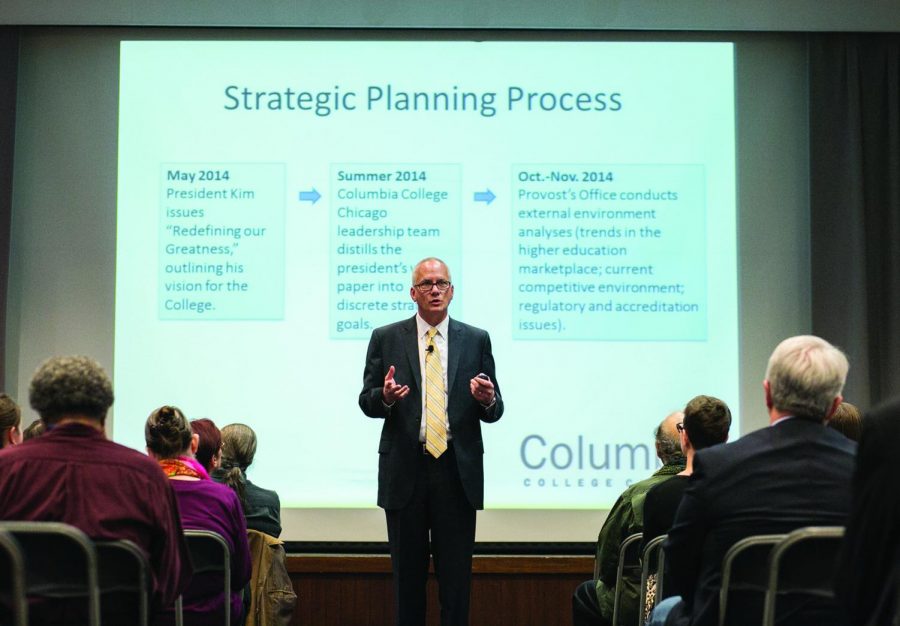Provost Stan Wearden discusses strategic plan
October 6, 2014
To commemorate his first 100 days as senior vice president and provost, Stan Wearden delivered an address to the college on Oct. 2 in the 618 S. Michigan Ave. Building.
Similar to the Q-and-A President Kwang-Wu Kim held last year at the close of his first 100 days, Wearden answered questions posed by members of the college community. It was Wearden’s first college-wide address since he spoke at Columbia in April as part of his interview process.
Wearden said he was excited to interact with students and faculty in a face-to-face environment, an opportunity he is rarely afforded.
“It’s nice to start it out this way because it’s such an inclusive group,” Wearden said. “Anybody can come, and it’s got that in-person, face-to-face quality that a newsletter or an email message or something just doesn’t have.”
The main topic of discussion was Wearden’s involvement in drafting the college’s strategic plan and how the college will implement feedback from the college community. Wearden said he had a similar experience at his previous place of employment, Kent State University in Kent, Ohio, and he predicts Columbia’s process will be successful.
The college is currently looking at six broad strategic goals. According to a Sept. 29 email from Kim, Wearden and 20 members of the Strategic Planning Committee convened for the first time Sept. 29 to begin the process of drafting the plan. Wearden, along with Kim and several members of his cabinet and the SPSC members, will work to complete the draft by April 2015, he said.
“Despite the apparent ambitiousness of it, this [completion goal] will work,” Wearden said. “There will be plenty of time for community input, for writing and revision, and there will be plenty of time for a second round of community input once we have a draft of the plan written.”
The next step in the process is an extensive environmental analysis, according to Wearden. The college wants to focus this strategic plan on thriving rather than surviving and growing the institution strategically unlike the previous prioritization efforts had done, he said.
The last time the college attempted to revise its strategic plan was when it underwent Blueprint Prioritization in 2012, a process that recommended the college phase out several academic programs and departments. Many of those recommendations were never implemented because former President Warrick L. Carter and several members of his cabinet left the institution shortly after the recommendations were released.
Kim wants the committee to have an ambitious, bold vision, Wearden said, but the committee can do so while being realistic and remembering what the core mission of the college is.
“We are going to use a variety of different techniques to make sure that everyone at Columbia who wants a voice in this has the opportunity to have that voice,” Wearden said.
The process will run from the end of October through the first week in December and will include roundtable discussions, focus groups, public sessions and also a new social media website, Wearden said. After that point, everything on the website and information from other events will be fed into a database and create an initial report of themes of discussion.
Following that, the subcommittees will meet in January and use the data to draft a statement of philosophy about each strategic goal, a set of objectives for implementation and a set of metrics for each of those objectives, Wearden said.
There will also be a quarterly review process to make sure everyone at the college is on the same page and that the strategic plan is still relevant, Wearden said.
“We really need to move forward together as an institution,” Wearden said. “That doesn’t mean the path needs to be narrow. It can be a broad path but we need to all be on the same path going in the same direction.”
Louis Silverstein, professor in the Humanities, History and Social Sciences Department and Assembly Committee member said that the college assembly is a forum for the entire community to be included on significant topics that would interest those people so they can act on it in some way.
“Rarely do we have a conversation at the college that includes all of the interests in the college, and meeting each other face-to-face establishes a link and that we’re in this together. … Face-to-face energizes people in a very different way,” Silverstein said.
Patricia McNair, an associate professor in the Creative Writing Department, attended the assembly and said her biggest concern was the college’s abundance of lecturers. She said she wished more students and faculty members attended the presentation.
“I think it’s important as a community that we stay involved and engaged in the new ideas that are coming from our new administration” McNair said.
There will also be a quarterly review process to make sure everyone at the college is on the same page and that the strategic plan is still relevant, Wearden said.
“We really need to move forward together as an institution,” Wearden said. “That doesn’t mean the path needs to be narrow. It can be a broad path, but we need to all be on the same path going in the same direction.”
Louis Silverstein, professor in the Humanities, History & Social Sciences Department and an Assembly Committee member said the college assembly is a forum for the entire community to be included in discussions on significant topics.
“Rarely do we have a conversation at the college that includes all of the interests in the college, and meeting each other face-to-face establishes a link and that we’re in this together,” Silverstein said.
Patricia McNair, an associate professor in the Creative Writing Department, said she wished more students and faculty members attended the presentation, but that it was a successful assembly overall.
“I think it’s important as a community that we stay involved and engaged in the new ideas that are coming from our new administration,” McNair said.








